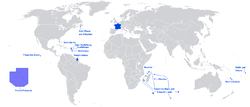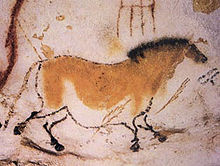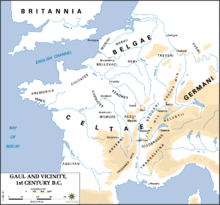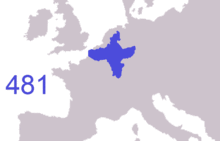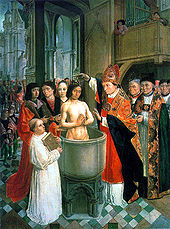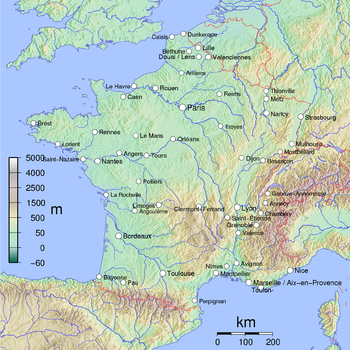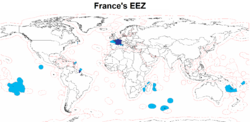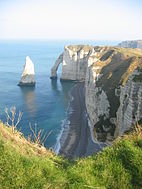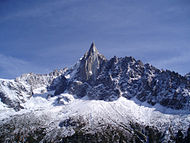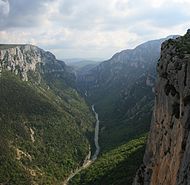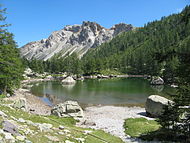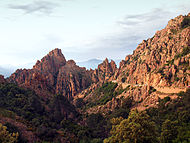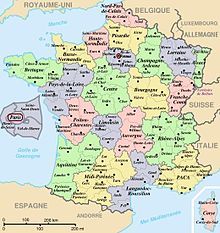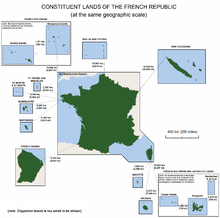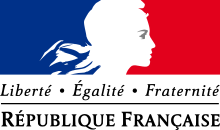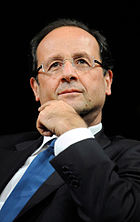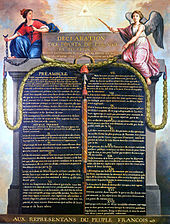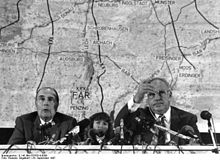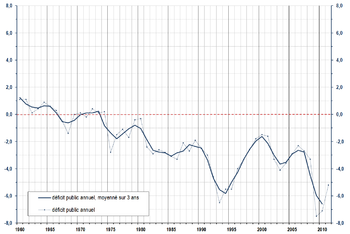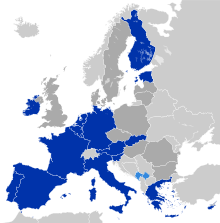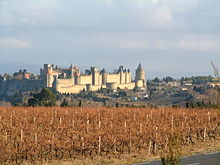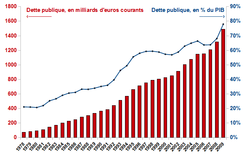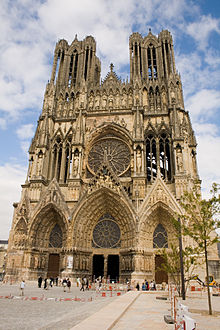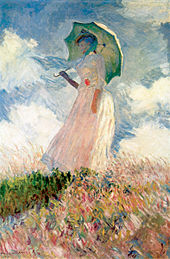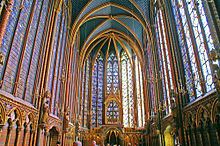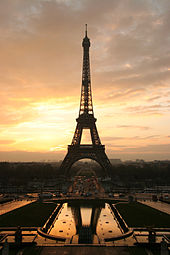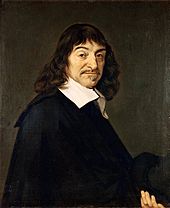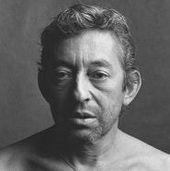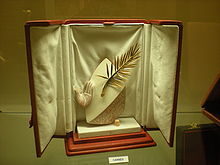
France
Did you know...
SOS Children have produced a selection of wikipedia articles for schools since 2005. SOS Child sponsorship is cool!
| French Republic République française
|
||||||
|---|---|---|---|---|---|---|
|
||||||
| Motto: " Liberté, égalité, fraternité" "Liberty, Equality, Fraternity" |
||||||
| Anthem: " La Marseillaise" |
||||||
| The logo of the French government |
||||||
|
Location of Metropolitan France (dark green)
– in Europe (green & dark grey) |
||||||
|
Territory of the French Republic.a
|
||||||
| Capital and largest city |
Paris 48°51.4′N 2°21.05′E |
|||||
| Official languages | French | |||||
| Demonym | French | |||||
| Government | Unitary semi-presidential constitutional republic | |||||
| - | President | François Hollande | ||||
| - | Prime Minister | Jean-Marc Ayrault | ||||
| Legislature | Parliament | |||||
| - | Upper house | Senate | ||||
| - | Lower house | National Assembly | ||||
| Formation | ||||||
| - | Frankish Kingdom (unified by Clovis) |
486 | ||||
| - | Kingdom of France ( Treaty of Verdun) |
843 | ||||
| - | French Republic ( National Convention) |
1792 | ||||
| - | Current constitution ( Fifth Republic) |
4 October 1958 | ||||
| Area | ||||||
| - | Total | 674,843 km2 ( 41st) 260,558 sq mi |
||||
| - | Metropolitan France | |||||
| - IGN | 551,695 km2 ( 47th) 213,010 sq mi |
|||||
| - Cadastre | 543,965 km2 ( 47th) 210,026 sq mi |
|||||
| Population | ||||||
| (2012) | ||||||
| - | Total | 65,350,000 ( 19th) | ||||
| - | Metropolitan France | 63,460,000 ( 22nd) | ||||
| - | Density | 116/km2 ( 89th) 301/sq mi |
||||
| GDP ( PPP) | 2012 estimate | |||||
| - | Total | $2.254 trillion ( 9th) | ||||
| - | Per capita | $35,548 ( 24th) | ||||
| GDP (nominal) | 2012 estimate | |||||
| - | Total | $2.609 trillion ( 5th) | ||||
| - | Per capita | $41,141 ( 23rd) | ||||
| Gini (2008) | 32.7 medium |
|||||
| HDI (2013) | very high · 20th |
|||||
| Currency |
EUR, XPF) |
|||||
| Time zone | CET ( UTC+1) | |||||
| - | Summer ( DST) | CEST ( UTC+2) | ||||
| Drives on the | right | |||||
| Calling code | 33 | |||||
| ISO 3166 code | FR | |||||
| Internet TLD | .fr | |||||
| a. | Excluding Adélie Land in Antarctica, where sovereignty is suspended. | |||||
France (English / ˈ f r æ n s / FRANSS or / ˈ f r ɑː n s / FRAHNSS; French: [fʁɑ̃s]), officially the French Republic (French: République française French pronunciation: [ʁepyblik fʁɑ̃sɛz]), is a unitary semi-presidential republic located mostly in Western Europe, with several overseas regions and territories. Metropolitan France extends from the Mediterranean Sea to the English Channel and the North Sea, and from the Rhine to the Atlantic Ocean. From its shape, it is often referred to in French as l’Hexagone ("The Hexagon").
France is the largest country in Western Europe and the third-largest in Europe as a whole. It possesses the second-largest exclusive economic zone in the world. France has been a major power with strong cultural, economic, military, and political influence in Europe and around the world. France has its main ideals expressed in the 18th-century Declaration of the Rights of Man and of the Citizen. In the 19th and early 20th centuries, France built the second-largest colonial empire of the time, ruling large portions of first North America and India and then Northwest and Central Africa; Madagascar; Indochina and southeast China; and many Caribbean and Pacific Islands.
France is a developed country, possessing the world's fifth-largest and Europe's second-largest economy by nominal GDP. It is also the world's ninth-largest by GDP at purchasing power parity. France is the wealthiest nation in Europe – and the fourth-wealthiest in the world – in aggregate household wealth. French citizens enjoy a high standard of living, high public education level, and one of the world's longest life expectancies. France has been listed as the world's "best overall health care" provider by the World Health Organization. It is the most-visited country in the world, receiving 79.5 million foreign tourists annually.
France has the world's fifth-largest nominal military budget, as well as (in terms of personnel) the largest military in the EU, the third-largest deployable force in NATO, and the 26th-largest military in the world. France also possesses the third-largest stockpile of nuclear weapons in the world – with around 300 active warheads as of 25 May 2010 – and the world's second-largest diplomatic corps (behind the United States). France is a founding member of the United Nations, one of the five permanent members of the UN Security Council, and a member of the Francophonie, the G8, G20, NATO, OECD, WTO, and the Latin Union. It is also a founding and leading member state of the European Union and the largest EU state by area. In 2013, France was listed 20th on the Human Development Index and, in 2010, 24th on the Corruption Perceptions Index.
Etymology
The name "France" comes from the Latin Francia, which means "country of the Franks". There are various theories as to the origin of the name of the Franks. One is that it is derived from the Proto-Germanic word frankon which translates as javelin or lance as the throwing axe of the Franks was known as a francisca. Another proposed etymology is that in an ancient Germanic language, Frank means free as opposed to slave.
History
Prehistory
The oldest traces of human life in what is now France date from approximately 1,800,000 years ago. Men were then confronted by a hard and variable climate, marked by several glacial eras which modified their framework of life and led them to a nomadic life of hunters-gatherers. France counts a large number of decorated caves from the upper Paleolithic era, including one of the most famous and best preserved: Lascaux ( Dordogne, approximately 18,000 BC).
At the end of the Last glacial period (10,000 BC), the climate softened and from approximately 7,000 BC, this part of Western Europe entered the Neolithic era and its inhabitants became sedentary. After a strong demographic and agricultural development between the 4th and 3rd millennia, metallurgy appeared at the end of the 3rd millennium, initially with the work of gold, copper and bronze, and later with iron. France counts numerous megalithic sites from the Neolithic period, including the exceptionally dense Carnac stones site ( Morbihan, approximately 3,300 BC).
Gaul

In 600 BC, Ionian Greeks, originating from Phocaea, founded the colony of Massalia (present-day Marseille), on the shores of the Mediterranean Sea, making it the oldest city of France. At the same time, some Gallic Celtic tribes penetrated some parts of the current territory of France, but this occupation spread in the rest of France only between the 5th and 3rd century BC.
The concept of Gaul emerged at that time; it corresponds to the territories of Celtic settlement ranging between the Rhine, the Atlantic Ocean, the Pyrenees and the Mediterranean Sea. The borders of modern France are approximately the same as those of ancient Gaul, which was inhabited by Celtic Gauls. Gaul was then a prosperous country, of which the southernmost part was heavily subject to Greek and Roman influences. However, around 390 BC, the Gallic chieftain Brennus and his troops made their way to Italy through the Alps, defeated the Romans in the Battle of the Allia, and besieged and ransomed Rome.
The Gallic invasion left Rome weakened and encouraged several subdued Italian tribes to rebel. One by one, over the course of the next 50 years, these tribes were defeated and brought back under Roman dominion. The Gauls continued to harass the region until 345 BC, when they entered into a formal peace treaty with Rome. But the Romans and the Gauls would maintain an adversarial relationship for the next several centuries and the Gauls would remain a threat in Italia.
Around 125 BC, the south of Gaul was conquered by the Romans, who called this region Provincia Romana ("Roman Province"), which over time evolved into the name Provence in French. Brennus' siege of Rome was still remembered by Romans, when Julius Caesar conquered the remainder of Gaul and overcame a revolt carried out by the Gallic chieftain Vercingetorix in 52 BC.
Gaul was divided by Augustus into Roman provinces, the principal ones being Gallia Narbonensis in the south, Gallia Aquitania in the south-west, Gallia Lugdunensis in the centre and Gallia Belgica in the north. Many cities were founded during the Gallo-Roman period, including Lugdunum (present-day Lyon), which is considered to be the capital of the Gauls. These cities were built in the traditional Roman style, with a forum, a theatre, a circus, an amphitheatre and thermal baths. The Gauls mixed with Roman settlers and eventually adopted Roman speech (Latin, from which the French language evolved) and Roman culture. The Roman polytheism merged with the Gallic paganism into the same syncretism.
From the 250s to the 280s of 3rd century AD, Roman Gaul suffered a serious crisis with its " limes" or fortified borders protecting the Empire being attacked on several occasions by Barbarians. The weakness of the central imperial power, at this time, led Gallo-Roman leaders to proclaim the independence of the short-lived Gallic Empire, which ended with the Battle of Châlons in 274, which saw Gaul reincorporated in the Roman Empire.
Nevertheless, the situation improved in the first half of the 4th century, which was a period of revival and prosperity for Roman Gaul. In 312, the emperor Constantin I converted to Christianity. Christians, persecuted until then, increased rapidly across the entire Roman Empire. But, from the beginning of the 5th century, the Barbarian Invasions resumed, and Germanic tribes, such as the Vandals, Suebi and Alans crossed the Rhine and settled in Gaul, Spain and other parts of the collapsing Roman Empire. The Visigoths were settled in SW Gaul in 417.
Kingdom of Francia (3rd century–843)
At the end of the Antiquity period, ancient Gaul was divided into several Germanic kingdoms ( Early Francia (North), Alamannia (North-East), Burgundia (East), Septimania (South), Visigothic Aquitania (South East)) and a remaining Gallo-Roman territory, known as the Kingdom of Syagrius (West). Simultaneously, Celtic Britons, fleeing the Anglo-Saxon invasion of Britannia, settled the western part of Armorica (far West of Gaul). As a result, the Armorican peninsula was renamed Brittany, Celtic culture was revived and independent petty kingdoms arose in this region.
The pagan Franks, from whom the ancient name of "Francie" was derived, originally settled the northern part of Gaul, but under Clovis I conquered most of the other kingdoms in northern and central Gaul. In 498, Clovis I was the first Germanic conqueror after the fall of the Roman Empire to convert to Catholic Christianity, rather than Arianism; thus France was given the title "Eldest daughter of the Church" (French: La fille aînée de l’Église) by the papacy, and the French kings would be called "the Most Christian Kings of France" (Rex Christianissimus).
The Franks embraced the Christian Gallo-Roman heritage and ancient Gaul was eventually renamed Francia ("Land of the Franks"). The Germanic Franks adopted Romanic languages, except in northern Gaul where Roman settlements were less dense and where Germanic languages emerged. Clovis made Paris his capital and established the Merovingian dynasty, but his kingdom would not survive his death. The Franks treated land purely as a private possession and divided it among their heirs, so four kingdoms emerged from Clovis's: Paris, Orléans, Soissons, and Rheims.
The last Merovingian kings, sometimes referred as Rois fainéants ("lazy kings"), effectively lost power to their mayors of the palace. One mayor of the palace, Charles Martel, defeated a Muslim invasion force from Hispania at the Battle of Tours (732) and earned respect and power within the Frankish kingdoms. His son, Pepin the Short, eventually seized the crown of Francia from the weakened Merovingians and founded the Carolingian dynasty. Pepin's son, Charlemagne, reunited the Frankish kingdoms and built a vast empire across Western and Central Europe.
Proclaimed Holy Roman Emperor by Pope Leo III and thus establishing in earnest the French government's longtime historical association with the Roman Catholic Church, Charlemagne tried to revive the Western Roman Empire and its cultural grandeur, from his Palace of Aachen. The efficient administration of this immense empire was ensured by high-level civil servants, carrying the, then non-hereditary, titles of counts (in charge of a County), marquis (in charge of a March), dukes (military commanders), etc.
Charlemagne's son, Louis I (emperor 814–840), kept the empire united; however, this Carolingian Empire would not survive his death. In 843, under the Treaty of Verdun, the empire was divided between Louis' three sons, with East Francia going to Louis the German, Middle Francia to Lothair I, and West Francia to Charles the Bald. Western Francia approximated the area occupied by, and was the precursor, to modern France.
During the course of the 9th and 10th centuries, continually threatened by Viking invasions, France became a very decentralised state: the nobility's titles and lands became hereditary, and the authority of the king became more religious than secular and thus was less effective and constantly challenged by powerful noblemen. Thus was established feudalism in France. Over time, some of the king's vassals would grow so powerful that they often posed a threat to the king. For example, after the Battle of Hastings in 1066, the Duke of Normandy added "King of England" to his titles, becoming both the vassal to (as Duke of Normandy) and the equal of (as king of England) the king of France.
Kingdom of France (843–1791)
The Carolingian dynasty ruled France until 987, when Hugh Capet, Duke of France and Count of Paris, was crowned King of the Franks. His descendants – the Capetians, the House of Valois, and the House of Bourbon – progressively unified the country through wars and dynastic inheritance into the Kingdom of France, which was fully declared in 1190 by Philip II Augustus. French knights took an active part in many of the Crusades that were fought between 1095 and 1291 to restore Christian control over the Holy Land. Crusaders were so predominately French that the word "crusader" in the Arabic language is simply known as Al-Franj or "The Franks" and Old French became the lingua franca of the Kingdom of Jerusalem.
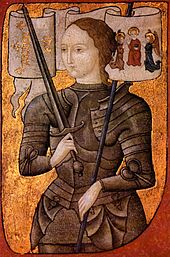
The Albigensian Crusade was launched in 1209 to eliminate the heretical Cathars in the south-western area of modern-day France. In the end, the Cathars were exterminated and the autonomous County of Toulouse was annexed into the kingdom of France. Later Kings expanded their territory to cover over half of modern continental France, including most of the North, Centre and West of France. Meanwhile, the royal authority became more and more assertive, centred around a hierarchically conceived society distinguishing nobility, clergy, and commoners.
Charles IV (The Fair) died without an heir in 1328. Under the rules of the Salic law adopted in 1316, the crown of France could not pass to a woman nor could the line of kinship pass through the female line. Accordingly, the crown passed to Philip of Valois, a cousin of Charles, rather than through the female line to Charles' nephew, Edward, who would soon become Edward III of England. During the reign of Philip of Valois, the French monarchy reached the height of its medieval power.
However, Philip's seat on the throne was contested by Edward III of England and in 1337, on the eve of the first wave of the Black Death, England and France went to war in what would become known as the Hundred Years' War. The exact boundaries changed greatly with time, but French landholdings of the English Kings remained extensive for decades.
With charismatic leaders, such as Joan of Arc and La Hire, strong French counterattacks won back all English continental territories, except Calais, which was captured in 1558 by the French. Like the rest of Europe, France was struck by the Black Death. Around 1340, France had a population of approximately 17 million, which by the end of the pandemic had declined by about one-half.
The French Renaissance saw a long set of wars, known as the Great Italian Wars, between the Kingdom of France and the powerful Holy Roman Empire. It also saw the first standardization of the French language, which would become the official language of France and the language of Europe's aristocracy. French explorers, such as Jacques Cartier or Samuel de Champlain, claimed lands in the Americas for France, paving the way for the expansion of the First French colonial empire.
The rise of Protestantism in Europe led France to a civil war known as the French Wars of Religion, where, in the most notorious incident, thousands of Huguenots were murdered in the St. Bartholomew's Day massacre of 1572. The Wars of Religion were ended by Henry IV's Edict of Nantes, which granted some freedom of religion to the Huguenots. Henry IV was later murdered by a Catholic fanatic and Huguenot rebellions persisted until the 18th century.
Under Louis XIII, the energetic actions of Cardinal Richelieu reinforced the centralization of the state, the royal power and French dominance in Europe, foreshadowing the reign of Louis XIV. During Louis XIV's minority and the regency of Queen Anne and Cardinal Mazarin, a period of trouble known as the Fronde occurred in France, which was at that time at war with Spain. This rebellion was driven by the great feudal lords and sovereign courts as a reaction to the rise of royal power in France.

The monarchy reached its peak during the 17th century and the reign of Louis XIV. By turning powerful feudal lords into courtiers at the Palace of Versailles, Louis XIV's personal power became unchallenged. Remembered for his numerous wars, he made France the leading European power of the time. At this time, France possessed the largest population in Europe (see Demographics of France) and had tremendous influence over European politics, economy, and culture. French became the most-used language in diplomacy, science, literature and international affairs, and remained so until the 20th century. In addition, France obtained many overseas possessions in the Americas, Africa and Asia. Louis XIV also revoked the Edict of Nantes, forcing thousands of Huguenots to exile.
Under Louis XV, France lost New France and most of its Indian possessions after its defeat in the Seven Years' War, which ended in 1763. Its continental territory kept growing, however, with notable acquisitions such as Lorraine (1766) and Corsica (1770). An unpopular king, Louis XV's weak rule, his ill-advised financial, political and military decisions, and his debauchery discredited the monarchy and arguably led to the French Revolution 15 years after his death.
Louis XVI, Louis XV's grandson, actively supported the Americans, who were seeking their independence from Great Britain (realized in the 1783 Treaty of Paris). The example of the American Revolution and the financial crisis which followed France's involvement in the war were two of the many contributing factors to the French Revolution.
Much of the Enlightenment occurred in French intellectual circles, and major scientific breakthroughs and inventions, such as the discovery of oxygen (1778) and the first hot air balloon carrying passengers (1783), were achieved by French scientists in the 18th century. Famous French explorers, such as Bougainville and Lapérouse, took part in the voyages of scientific exploration through maritime expeditions around the globe. The Enlightenment philosophy, in which reason is advocated as the primary source for legitimacy and authority, undermined the power of and support for the monarchy and helped pave the way for the French Revolution.
Republics and Empires (1792-)
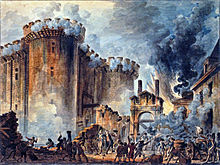
After the storming of the Bastille on 14 July 1789, the absolute monarchy was abolished and France became a constitutional monarchy. Through the Declaration of the Rights of Man and of the Citizen, France established fundamental rights for French citizens and all men without exception. The Declaration affirms "the natural and imprescriptible rights of man" to "liberty, property, security and resistance to oppression". It called for the destruction of aristocratic privileges (such as exemptions from taxation) and proclaimed freedom and equal rights for all men, as well as access to public office based on talent rather than birth.
The monarchy was restricted, and all citizens were to have the right to take part in the legislative process. Freedom of speech and press were declared, and arbitrary arrests outlawed. The Declaration also asserted the principles of popular sovereignty, in contrast to the divine right of kings that characterized the French monarchy, and social equality among citizens, eliminating the privileges of the nobility and clergy.

While Louis XVI, as a constitutional king, enjoyed broad popularity among the population, his disastrous flight to Varennes seemed to justify the rumors that the king tied his hopes of political salvation to the dubious prospects of foreign invasion. The credibility of the king was deeply undermined and the abolition of the monarchy and the establishment of a republic became an ever increasing possibility.
As European monarchies gathered against the new régime, to restore the French absolute monarchy, the Duke of Brunswick, commanding general of the Austro–Prussian Army, issued a Manifesto, in which he threatened the destruction of Paris if any harm should come to the king or his family. The foreign threat exacerbated France's political turmoil and deepened the passion and sense of urgency among the various factions and war was declared against Austria the 20 April 1792. Mob violences occurred during the insurrection of the 10 August 1792 and the following month. As a result of the spike in public violence and the political instability of the constitutional monarchy, the Republic was proclaimed on 22 September 1792.
Louis XVI (and later his wife Marie Antoinette) was convicted of treason and guillotined in 1793. Facing increasing pressures from European monarchies, internal guerrilla wars and counterrevolutions (like the War in the Vendée or the Chouannerie), the young Republic fell into the Reign of Terror. Between 1793 and 1794, 16,000 to 40,000 people were executed. In Western France, the civil war between the Bleus (the "Blues", supporters of the Revolution) and the Blancs (the "Whites", supporters of the Monarchy) lasted from 1793 to 1796 and cost between 200,000 and 450,000 lives (80,000 to 200,000 Patriotes and 120,000 to 250,000 Vendéens).
Both foreign armies and French counterrevolutionnaries were crushed and the French Republic survived. Furthermore, the French Republic extended greatly its boundaries and established " Sister Republics" in the surrounding countries. As the threat of a foreign invasion receded and France became mostly pacified, the Thermidorian Reaction put an end to Robespierre's rule and, eventually, to the Terror. The abolition of slavery and the male universal suffrage, enacted during this radical phase of the revolution, were cancelled by subsequent governments.
After a short-lived governmental scheme, Napoleon Bonaparte seized control of the Republic in 1799 and was appointed by plebiscite First Consul and later Emperor of the French Empire (1804–1814/1815). As a continuation of the wars sparked by the European monarchies against the French Republic, changing sets of European Coalitions declared wars on Napoleon's French Empire. His armies conquered most of continental Europe, while members of the Bonaparte family were appointed as monarchs in some of the newly established kingdoms.
These victories led to the worldwide expansion of French revolutionary ideals and reforms, such as the Metric system, the Napoleonic Code or the Declaration of the Rights of Man and of the Citizen. After the catastrophic Russian campaign, Napoleon was finally defeated and the Bourbon monarchy restored. About a million Frenchmen died during the Napoleonic Wars.

After his brief return from exile, Napoleon was finally defeated in 1815 at the Battle of Waterloo, the monarchy was re-established (1815–1830), with new constitutional limitations. The discredited Bourbon dynasty was overthrown by the civil uprising of 1830, which established the constitutional July Monarchy, which lasted until 1848, when the French Second Republic was proclaimed, in the wake of the 1848 European revolutions. The abolition of slavery and the male universal suffrage, both briefly enacted during the French Revolution were finally re-enacted in 1848.
In 1852, the president of the French Republic Louis-Napoléon Bonaparte, Napoleon I’s nephew, was proclaimed emperor of the second Empire, as Napoleon III. He multiplied French interventions abroad, especially in Crimea, in Mexico and Italy, which resulted in the annexation of Savoy and Nice. Napoleon III was eventually unseated following defeat in the Franco-Prussian war of 1870 and his regime was replaced by the Third Republic.
France had colonial possessions, in various forms, since the beginning of the 17th century to the 18th century. In the 19th and 20th centuries, its global overseas colonial empire extended greatly and culminated as the second largest in the world behind the British Empire. At its peak, between 1919 and 1939, the second French colonial empire extended over 12,347,000 square kilometres (4,767,000 sq mi) of land. Including metropolitan France, the total area of land under French sovereignty reached 12,898,000 square kilometres (4,980,000 sq mi) in the 1920s and 1930s, which is 8.6% of the world's land area.
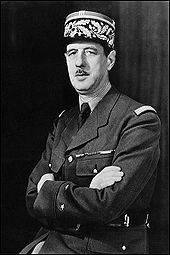
France was a member of the Triple Entente when World War I broke out. A small part of Northern France was occupied, but France and its allies eventually emerged victorious against the Central Powers, at a tremendous human and material cost: the First World War left 1.4 million French soldiers dead, 4.29% of its population, between 27 and 30% of the conscript classes of 1912-1915.
The interbellum years were marked by intense international tensions an a variety of social reforms introduced by the Popular Front government ( Annual leave, working time reduction, women in Government among others). France was occupied following the German Blitzkrieg campaign in World War II, with metropolitan France divided into a German occupation zone in the north and Vichy France, a newly established authoritarian regime collaborating with Germany, in the south. The Allies and the French Resistance eventually emerged victorious from the Axis powers and French sovereignty was restored.
The Fourth Republic was established after World War II and saw spectacular economic growth (les Trente Glorieuses). Suffrage was extended to women in 1944. France was one of the founding members of the NATO (1949), which was the Western counterpart of the Warsaw Pact system of collective defence. France attempted to regain control of French Indochina but was defeated by the Viet Minh at the Battle of Dien Bien Phu in 1954. Only months later, France faced a new conflict in Algeria. The debate over whether or not to keep control of Algeria, then home to over one million European settlers, wracked the country and nearly led to civil war.
In 1958, the weak and unstable Fourth Republic gave way to the Fifth Republic, which contained a strengthened Presidency. In the latter role, Charles de Gaulle managed to keep the country together while taking steps to end the war. The Algerian War was concluded with peace negotiations in 1962 that led to Algerian independence. France granted independence progressively to its colonies, the last one being Vanuatu in 1980. A vestige of the colonial empire are the French overseas departments and territories.
In the wake of a worldwide series of protests, the May 1968 revolt, although a political failure for the protesters, had an enormous social impact. In France, it is considered to be the watershed moment when a conservative moral ideal (religion, patriotism, respect for authority) shifted towards a more liberal moral ideal.
France has been at the forefront of the European Union member states seeking to exploit the momentum of monetary union to create a more unified and capable European Union political, defence, and security apparatus.
Geography
Metropolitan France is situated mostly between latitudes 41° and 51° N ( Dunkirk is just north of 51°), and longitudes 6° W and 10° E, on the western edge of Europe, and thus lies within the northern temperate zone.
From southwest to northeast, France shares borders with Spain, Andorra, Monaco, Italy, Switzerland, Germany, Luxembourg, and Belgium. France also borders Suriname to its west and Brazil to its east and south, by way of the overseas region of French Guiana, which is considered an integral part of the republic (like Alaska and Hawaii are to the United States, or Kaliningrad is to Russia).
Corsica and the French mainland form Metropolitan France; Guadeloupe, Martinique, Réunion, and Mayotte form, with French Guiana, the overseas regions. These two integral groupings, along with several overseas collectivities and one territory, comprise the French Republic. The collectivity of Saint Martin borders Sint Maarten, a constituent country of the Kingdom of the Netherlands; however, since, Saint Martin is significantly autonomous of the French government, this is not considered an international border.
The European territory of France covers 547,030 square kilometres (211,209 sq mi), having the largest area among European Union members. France possesses a wide variety of landscapes, from coastal plains in the north and west to mountain ranges of the Alps in the south-east, the Massif Central in the south-central and Pyrenees in the south-west.
At 4,810.45 metres (15,782 ft) above sea level, the highest point in Western Europe, Mont Blanc, is situated in the Alps on the border between France and Italy. France also has extensive river systems such as the Seine, the Loire, the Garonne, and the Rhone, which divides the Massif Central from the Alps and flows into the Mediterranean Sea at the Camargue. Corsica lies off the Mediterranean coast.
France's total land area, with its overseas departments and territories (excluding Adélie Land), is 674,843 km2 (260,558 sq mi), 0.45% of the total land area on Earth. However, France possesses the second-largest Exclusive Economic Zone (EEZ) in the world, covering 11,035,000 km2 (4,260,637 sq mi), approximately 8% of the total surface of all the EEZs of the world, just behind the United States (11,351,000 km2 or 4,382,646 sq mi) and ahead of Australia (8,232,000 km2 or 3,178,393 sq mi). According to a different calculation cited by the Pew Research Centre, the EEZ of France would be 10,084,201 km2 (3,893,532 sq mi), still behind the United States (12,174,629 km2 or 4,700,651 sq mi), and still ahead of Australia (8,980,568 km2 or 3,467,417 sq mi) and Russia (7,566,673 km2 or 2,921,509 sq mi).
The north and northwest have a temperate climate, while a combination of maritime influences, latitude and altitude produce a varied climate in the rest of Metropolitan France. In the south-east a Mediterranean climate prevails. In the west, the climate is predominantly oceanic with a high level of rainfall, mild winters and cool to warm summers. Inland the climate becomes more continental with hot, stormy summers, colder winters and less rain. The climate of the Alps and other mountainous regions is mainly alpine, with the number of days with temperatures below freezing over 150 per year and snow cover lasting for up to six months.
| Landscapes and climates of France | ||||||||||||||||||||||
|
||||||||||||||||||||||
Environment
France was one of the first countries to create a Ministry of the Environment, in 1971. Although France is one of the most industrialised and developed countries, it is ranked only seventeenth by carbon dioxide emissions, behind such less populous nations as Canada, Saudi Arabia or Australia. This situation results from the French government's decision to invest in nuclear power in 1974 (after the 1973 oil crisis), which now accounts for 78% of France's electricity production and explains why France pollutes less than comparable countries.
Like all European Union members, France agreed to cut carbon emissions by at least 20% of 1990 levels by the year 2020, in comparison the USA agreed to a cut of 4% of its emissions whereas China stated it wanted to "reduce its carbon intensity by 40–45% by the year 2020" (compared with 2005 levels), which means with a GDP growth of 8% yearly an augmentation of 80% to 250% of the Chinese carbon emissions by 2020.
In 2009, the French carbon dioxide emissions per capita level is lower than the Chinese one.
France was even set to impose a carbon tax in 2009 at 17 Euros per tonne of carbon dioxide emitted. The carbon tax would have brought in 4.3 billion Euros of revenue per year. However, 6 months later, the plan for a carbon tax was abandoned for various reasons, one being that French companies would have a more difficult time competing with companies in neighboring countries who would not have to pay such steep taxes on carbon dioxide emissions. Instituting a carbon tax was also an unpopular political move for President Sarkozy.
In 2010, a study at Yale and Columbia universities ranked France the 7th most environmentally conscious country in the world.
Forests account for 28% of the land area of France. French forests are also some of the most diversified of Europe, with more than 140 differents varieties of trees. There are 9 national parks and 46 natural parks in France. France wants to convert 20% of its Exclusive Economic Zone in a Marine Protected Area by 2020.
Administrative divisions
France is divided into 27 administrative regions. 22 are in metropolitan France (21 are on the continental part of metropolitan France; one is the territorial collectivity of Corsica), and five are overseas regions. The regions are further subdivided into 101 departments which are numbered (mainly alphabetically). This number is used in postal codes and vehicle number plates amongst others.
The 101 departments are subdivided into 341 arrondissements which are, in turn, subdivided into 4,051 cantons. These cantons are then divided into 36,697 communes, which are municipalities with an elected municipal council. There also exist 2,588 intercommunal entities grouping 33,414 of the 36,697 communes (i.e. 91.1% of all the communes). Three communes, Paris, Lyon and Marseille are also subdivided into 45 municipal arrondissements.
The regions, departments and communes are all known as territorial collectivities, meaning they possess local assemblies as well as an executive. Arrondissements and cantons are merely administrative divisions. However, this was not always the case. Until 1940, the arrondissements were also territorial collectivities with an elected assembly, but these were suspended by the Vichy regime and definitely abolished by the Fourth Republic in 1946.
Metropolitan regions
| Region | Departments | Capital |
|---|---|---|
| |
Bas-Rhin, Haut-Rhin | |
| |
Dordogne, Gironde, Landes, Lot-et-Garonne, Pyrénées-Atlantiques | |
| |
Allier, Cantal, Haute-Loire, Puy-de-Dôme | |
| |
Côtes-d'Armor, Finistère, Ille-et-Vilaine, Morbihan | |
| |
Côte-d'Or, Nièvre, Saône-et-Loire, Yonne | |
| |
Cher, Eure-et-Loir, Indre, Indre-et-Loire, Loiret, Loir-et-Cher | |
| |
Ardennes, Aube, Haute-Marne, Marne | |
| |
Corse-du-Sud, Haute-Corse | |
| |
Doubs, Haute-Saône, Jura, Territoire de Belfort | |
| |
Essonne, Hauts-de-Seine, Paris, Seine-et-Marne, Seine-Saint-Denis, Val-de-Marne, Val-d'Oise, Yvelines | |
| |
Aude, Gard, Hérault, Lozère, Pyrénées-Orientales | |
| |
Corrèze, Creuse, Haute-Vienne | |
| |
Meurthe-et-Moselle, Meuse, Moselle, Vosges | |
| |
Calvados, Manche, Orne | |
| |
Ariège, Aveyron, Gers, Haute-Garonne, Hautes-Pyrénées, Lot, Tarn, Tarn-et-Garonne | |
| |
Nord, Pas-de-Calais | |
| |
Loire-Atlantique, Maine-et-Loire, Mayenne, Sarthe, Vendée | |
| |
Aisne, Oise, Somme | |
| |
Charente, Charente-Maritime, Deux-Sèvres, Vienne | |
| |
Alpes-de-Haute-Provence, Alpes-Maritimes, Bouches-du-Rhône, Hautes-Alpes, Var, Vaucluse | |
| |
Ain, Ardèche, Drôme, Haute-Savoie, Isère, Loire, Rhône, Savoie | |
| |
Eure, Seine-Maritime | |
Overseas regions
Among the 101 departments of France, five (French Guiana, Guadeloupe, Martinique, Mayotte, and Réunion) are in overseas regions (ROMs) that are also simultaneously overseas departments (DOMs) and are an integral part of France (and the European Union) and thus enjoy a status similar to metropolitan departments.
| Name | Constitutional status | Capital |
|---|---|---|
| Overseas region (régions d'outre-mer) and simultaneously overseas department (département d'outre-mer or DOM) | Cayenne | |
| Overseas region (régions d'outre-mer) and simultaneously overseas department (département d'outre-mer or DOM) | Basse-Terre | |
| Overseas region (régions d'outre-mer) and simultaneously overseas department (département d'outre-mer or DOM) | Fort-de-France | |
| Overseas region (régions d'outre-mer) and simultaneously overseas department (département d'outre-mer or DOM) | Mamoudzou | |
| Overseas region (régions d'outre-mer) and simultaneously overseas department (département d'outre-mer or DOM) | Saint-Denis |
Overseas territories and collectivities
In addition to the 27 regions and 101 departments, the French Republic also has five overseas collectivities (French Polynesia, Saint Barthélemy, Saint Martin, Saint Pierre and Miquelon, and Wallis and Futuna), one sui generis collectivity (New Caledonia), one overseas territory (French Southern and Antarctic Lands), and one island possession in the Pacific Ocean ( Clipperton Island).
Overseas collectivities and territories form part of the French Republic, but do not form part of the European Union or its fiscal area (with the exception of St. Bartelemy, which seceded from Guadeloupe in 2007). The Pacific Collectivities (COMs) of French Polynesia, Wallis and Fortuna, and New Caledonia continue to use the CFP franc whose value is linked to that of the euro. In contrast, the five overseas regions used the French franc and now use the euro.
| Name | Constitutional status | Capital |
|---|---|---|
| State private property under the direct authority of the French government | Uninhabited | |
| Designated as an overseas land (pays d'outre-mer or POM), the status is the same as an overseas collectivity. | Papeete | |
| Overseas territory (territoire d'outre-mer or TOM) | Port-aux-Français | |
| Sui generis collectivity | Nouméa | |
| Overseas collectivity (collectivité d'outre-mer or COM) | Gustavia | |
| Overseas collectivity (collectivité d'outre-mer or COM) | Marigot | |
| Overseas collectivity (collectivité d'outre-mer or COM). Still referred to as a collectivité territoriale. | Saint-Pierre | |
| Overseas collectivity (collectivité d'outre-mer or COM). Still referred to as a territoire. | Mata-Utu |
Governance
Government
The French Republic is a unitary semi-presidential republic with strong democratic traditions. The constitution of the Fifth Republic was approved by referendum on 28 September 1958. It greatly strengthened the authority of the executive in relation to parliament. The executive branch itself has two leaders: the President of the Republic, currently François Hollande, who is head of state and is elected directly by universal adult suffrage for a 5-year term (formerly 7 years), and the Government, led by the president-appointed Prime Minister, currently Jean-Marc Ayrault.
The French parliament is a bicameral legislature comprising a National Assembly (Assemblée Nationale) and a Senate. The National Assembly deputies represent local constituencies and are directly elected for 5-year terms. The Assembly has the power to dismiss the cabinet, and thus the majority in the Assembly determines the choice of government. Senators are chosen by an electoral college for 6-year terms (originally 9-year terms), and one half of the seats are submitted to election every 3 years starting in September 2008.
The Senate's legislative powers are limited; in the event of disagreement between the two chambers, the National Assembly has the final say. The government has a strong influence in shaping the agenda of Parliament.
French politics are characterised by two politically opposed groupings: one left-wing, centred around the French Socialist Party, and the other right-wing, centred previously around the Rassemblement pour la République (RPR) and now its successor the Union for a Popular Movement (UMP). Since the 2012 elections, the executive branch is currently composed mostly of the Socialist Party.
Law
France uses a civil legal system; that is, law arises primarily from written statutes; judges are not to make law, but merely to interpret it (though the amount of judicial interpretation in certain areas makes it equivalent to case law). Basic principles of the rule of law were laid in the Napoleonic Code (which was, in turn, largely based on the royal law codified under Louis XIV). In agreement with the principles of the Declaration of the Rights of Man and of the Citizen law should only prohibit actions detrimental to society. As Guy Canivet, first president of the Court of Cassation, wrote about the management of prisons: Freedom is the rule, and its restriction is the exception; any restriction of Freedom must be provided for by Law and must follow the principles of necessity and proportionality. That is, Law should lay out prohibitions only if they are needed, and if the inconveniences caused by this restriction do not exceed the inconveniences that the prohibition is supposed to remedy.
French law is divided into two principal areas: private law and public law. Private law includes, in particular, civil law and criminal law. Public law includes, in particular, administrative law and constitutional law. However, in practical terms, French law comprises three principal areas of law: civil law, criminal law and administrative law. Criminal laws can only address the future and not the past (criminal ex post facto laws are prohibited). While administrative law is often a subcategory of civil law in many countries, it is completely separated in France and each body of law is headed by a specific supreme court: ordinary courts (which handle criminal and civil litigation) are headed by the Court of Cassation and administrative courts are headed by the Council of State.
To be applicable, every law must be officially published in the Journal Officiel de la République Française.
France does not recognize religious law, nor does it recognize religious beliefs or morality as a motivation for the enactment of prohibitions. As a consequence, France has long had neither blasphemy laws nor sodomy laws (the latter being abolished in 1791). However, "offenses against public decency" (contraires aux bonnes mœurs) or disturbing public order (trouble à l'ordre public) have been used to repress public expressions of homosexuality or street prostitution. With such emphasis on public order, laws sentencing racism, sexism or antisemitism are also old and important. For instance, laws prohibiting discriminatory speech in the press are as old as 1881. Some consider however that hate speech laws in France are too broad or severe and damage freedom of speech.
France's attitude towards freedom of religion is complex. Freedom of religion is guaranteed by the constitutional rights set forth in the 1789 Declaration of the Rights of Man and of the Citizen. However, since the 1905 French law on the Separation of the Churches and the State, the State tries to prevent its policy-making from being influenced by religion and became suspicious in recent decades towards new religious tendencies of the French society: the Parliament has listed many religious movements as dangerous cults since 1995, and has banned wearing conspicuous religious symbols in schools since 2004. In 2010, it banned the wearing of face-covering Islamic veils in public. As some have complained that they have suffered from discrimination thus, and after criticism by human rights groups such as Amnesty International and Human Rights Watch, these laws remain controversial, although they are supported by most of the population.
France is tolerant of the LGBT community. Since 1999, civil unions for homosexual couples are permitted, although same-sex marriage is illegal in France. On April 23, lawmakers approved a bill which would legalize same-sex marriage. It is expected to be signed into law by President Hollande.
Foreign relations
France is a member of the United Nations and serves as one of the permanent members of the UN Security Council with veto rights. It is also a member of the G8, World Trade Organization (WTO), the Secretariat of the Pacific Community (SPC) and the Indian Ocean Commission (COI). It is an associate member of the Association of Caribbean States (ACS) and a leading member of the International Francophone Organisation (OIF) of fifty-one fully or partly French-speaking countries.

France hosts the headquarters of the OECD, UNESCO, Interpol, Alliance Base and the International Bureau for Weights and Measures. France has the second largest network of diplomatic missions in the world, second only to the USA. In 1953, France received a request from the United Nations to pick a coat of arms that would represent it internationally. Thus the French emblem was adopted and is currently used on passports.
Postwar French foreign policy has been largely shaped by membership of the European Union, of which it was a founding member. Since the 1960s, France has developed close ties with reunified Germany to become the most influential driving force of the EU. In the 1960s, France sought to exclude the British from the European unification process, seeking to build its own standing in continental Europe. However since 1904, France has maintained an " Entente cordiale" with the United Kingdom, and there has been a strengthening of links between the countries, especially on a military level.
France is a member of the North Atlantic Treaty Organisation (NATO), but under President de Gaulle, it excluded itself from the joint military command to protest the special relationship between the United States and Britain and to preserve the independence of French foreign and security policies. France vigorously opposed the 2003 invasion of Iraq, straining bilateral relations with the US and the UK. However, as a result of Nicolas Sarkozy's (much criticised in France by the leftists and by a part of the right) pro-American politics, France rejoined the NATO joint military command on 4 April 2009.
In the early 1990s, the country drew considerable criticism from other nations for its underground nuclear tests in French Polynesia.
France retains strong political and economic influence in its former African colonies ( Françafrique) and has supplied economic aid and troops for peace-keeping missions in Côte d'Ivoire and Chad. Recently, after the unilateral declaration of independence of northern Mali by the Tuareg MNLA and the subsequent regional conflict with several Islamist groups including Ansar Dine and MOJWA, France and other African states intervened to help the Malian Army to retake control.
In 2009, France was the second largest (in absolute numbers) donor of development aid in the world, behind the US, and ahead of Germany, Japan and the UK. This represents 0.5% of its GDP, in this regard rating France as tenth largest donor on the list. The organisation managing the French help is the French Development Agency, which finances primarily humanitarian projects in sub-Saharan Africa. The main goals of this help are "developing infrastructure, access to health care and education, the implementation of appropriate economic policies and the consolidation of the rule of law and democracy."
Military
The French Armed Forces (Armées françaises) are the military and paramilitary forces of France, under the president as supreme commander. They consist of the French Army (Armée de Terre), French Navy (Marine Nationale), the French Air Force (Armée de l'Air) and the auxiliary paramilitary force, the National Gendarmerie (Gendarmerie nationale) and are among the largest armed forces in the world. While administratively a part of the French armed forces, and therefore under the purview of the Ministry of Defence, the Gendarmerie is operationally attached to the Ministry of the Interior.
The gendarmerie is a military police force which serves for the most part as a rural and general purpose police force. It encompasses the counter terrorist units of the Parachute Intervention Squadron of the National Gendarmerie (Escadron Parachutiste d'Intervention de la Gendarmerie Nationale) and the National Gendarmerie Intervention Group (Groupe d'Intervention de la Gendarmerie Nationale). One of the French intelligence units, the Directorate-General for External Security (Direction Générale de la Sécurité Extérieure) reports to the Ministry of Defence. The other, the Central Directorate of Interior Intelligence (Direction Centrale du Renseignement Intérieur), reports directly to the Ministry of the Interior. There has been no national conscription since 1997.
France is a permanent member of the Security Council of the UN, and a recognised nuclear state since 1960. France has signed and ratified the Comprehensive Nuclear-Test-Ban Treaty (CTBT) and acceeded to the Nuclear Non-Proliferation Treaty. France's annual military expenditure in 2011 was US$62.5 billion, or 2.3% of its GDP making it the fifth biggest military spender in the world after the United States, China, Russia and the United Kingdom.
French nuclear deterrence, (formerly known as “ Force de Frappe”), relies on complete independence. The current French nuclear force consists of four Triomphant class submarines equipped with submarine-launched ballistic missiles. In addition to the submarine fleet, it is estimated that France has about 60 ASMP medium-range air-to-ground missiles with nuclear warheads, of which around 50 are deployed by the Air Force using the Mirage 2000N long-range nuclear strike aircraft, while around 10 are deployed by the French Navy's Super Étendard Modernisé (SEM) attack aircraft which operate from the nuclear-powered aircraft carrier Charles de Gaulle. The new Rafale F3 aircraft will gradually replace all Mirage 2000N and SEM in the nuclear strike role with the improved ASMP-A missile with a nuclear warhead.
France has major military industries with one of the largest aerospace industries in the world. Its industries have produced such equipment as the Rafale fighter, the Charles de Gaulle aircraft carrier, the Exocet missile and the Leclerc tank amongst others. Despite withdrawing from the Eurofighter project, France is actively investing in European joint projects such as the Eurocopter Tiger, multipurpose frigates, the UCAV demonstrator nEUROn and the Airbus A400M. France is a major arms seller, with most of its arsenal's designs available for the export market with the notable exception of nuclear-powered devices.
The military parade held in Paris each 14 July for France's national day is the oldest and largest regular military parade in Europe.
Government finance
In April and May, 2012, France held a presidential election in which the winner François Hollande had opposed austerity measures, promising to eliminate France's budget deficit by 2017. The new government stated that it aimed to cancel recently enacted tax cuts and exemptions for the wealthy, raising the top tax bracket rate to 75% on incomes over a million euros, restoring the retirement age to 60 with a full pension for those who have worked 42 years, restoring 60,000 jobs recently cut from public education, regulating rent increases; and building additional public housing for the poor.
In June, Hollande's Socialist Party won a supermajority in legislative elections capable of amending the French Constitution and enabling the immediate enactment of the promised reforms. French government bond interest rates fell 30% to record lows, less than 50 basis points above German government bond rates.
French government debt
The French government has run a budget deficit each year since the early 1970s. In mid-2012, French government debt levels reached 1.833 billion euros. This debt level was the equivalent of 91% of French GDP.
Under European Union rules, member states are supposed to limit their debt to 60 percent of output or be reducing the ratio structurally towards this ceiling, and run public deficits of no more than 3.0 percent of GDP.
In late 2012, credit rating agencies warned that growing French government debt levels risked France's AAA credit rating, raising the possibility of a future credit downgrade and subsequent higher borrowing costs for the French government.
Economy

A member of the G8 group of leading industrialised countries, it is ranked as the world's fifth largest and Europe's second largest economy by nominal GDP; with 39 of the 500 biggest companies of the world in 2010, France ranks world's 4th and Europe's 1st in the Fortune Global 500 ahead of Germany and the UK. France joined 11 other EU members to launch the euro on 1 January 1999, with euro coins and banknotes completely replacing the French franc (₣) in early 2002.
France has a mixed economy which combines extensive private enterprise (nearly 2.5 million companies registered) with substantial (though declining) state enterprise and government intervention (see dirigisme). The government retains considerable influence over key segments of infrastructure sectors, with majority ownership of railway, electricity, aircraft, nuclear power and telecommunications. It has been gradually relaxing its control over these sectors since the early 1990s.
The government is slowly corporatising the state sector and selling off holdings in France Télécom, Air France, as well as the insurance, banking, and defence industries. France has an important aerospace industry led by the European consortium Airbus, and has its own national spaceport, the Centre Spatial Guyanais.
According to the World Trade Organization (WTO), in 2009 France was the world's sixth-largest exporter and the fourth-largest importer of manufactured goods. In 2008, France was the third-largest recipient of foreign direct investment among OECD countries at $117.9 billion, ranking behind Luxembourg (where foreign direct investment was essentially monetary transfers to banks located in that country) and the United States ($316.1 billion), but above the United Kingdom ($96.9 billion), Germany ($24.9 billion), or Japan ($24.4 billion).
In the same year, French companies invested $220 billion outside of France, ranking France as the second most important outward direct investor in the OECD, behind the United States ($311.8 billion), and ahead of the United Kingdom ($111.4 billion), Japan ($128 billion) and Germany ($156.5 billion). With 39 of the 500 biggest companies of the world in 2010, France ranks 4th in the Fortune Global 500, behind the USA, Japan and China, but ahead of Germany and the UK.
Financial services, banking and the insurance sector are an important part of France's economy. The Paris stock exchange market (French: La Bourse de Paris) is an ancient institution, as it was created by Louis XV in 1724. In 2000, the stock exchanges of Paris, Amsterdam and Bruxelles merged into Euronext. In 2007, Euronext merged with the New York stock exchange to form NYSE Euronext, the world's largest stock exchange. Euronext Paris, the French branch of the NYSE Euronext group is Europe's second largest stock exchange market, behind the London Stock Exchange.
French companies have maintained key positions in the Insurance and Banking industries: AXA is the world's largest insurance company, and is ranked by Fortune the ninth richest corporation by revenues. The leading French banks are BNP Paribas and the Crédit Agricole, ranking as the world's 1st and 6th largest banks in 2010 (determined by the amount of assets), while the Société Générale group was ranked the world's eight largest in 2008–2009.
France is the smallest emitter of carbon dioxide among the seven most industrialized countries in the world, due to its heavy investment in nuclear power. As a result of large investments in nuclear technology, most of the electricity produced in the country is generated by 59 nuclear power plants (78% in 2006, up from only 8% in 1973, 24% in 1980, and 75% in 1990). In this context, renewable energies (see the power cooperative Enercoop) are having difficulties taking off the ground.
Agriculture
France has historically been an important producer of agricultural products. Large tracts of fertile land, the application of modern technology, and EU subsidies have combined to make France the leading agricultural producer and exporter in Europe (representing alone 20% of the EU's agricultural production) and the world's third biggest exporter of agricultural products.
Wheat, poultry, dairy, beef, and pork, as well as an internationally recognized processed foods are the primary French agricultural exports. Rosé wines are primarily consumed within the country, but champagne and Bordeaux wines are major exports, being known worldwide. EU agriculture subsidies to France have decreased for the last years, but still amounted to $8 billion in 2007. This same year, France sold 33.4 billion euros of transformed agricultural products.
Agriculture is thus an important sector of France's economy : 3.5% of the active population is employed in agriculture, whereas the total agri-food industry made up 4.2% of French GDP in 2005.
Labour market
The French GDP per capita is similar to the GDP per capita of other comparable European countries such as Germany and the United Kingdom. GDP per capita is determined by (i) productivity per hour worked, which in France is the highest of the G8 countries in 2005, according to the OECD, (ii) the number of hours worked, which is one the lowest of developed countries, and (iii) the employment rate. France has one of the lowest 15–64 years employment rates of the OECD countries: in 2004, only 69% of the French population aged 15–64 years were in employment, compared to 80% in Japan, 79% in the UK, 77% in the US, and 71% in Germany.
This gap is due to the very low employment rates at both age extremes: the employment rate of people aged 55–64 was 38.3% in 2007, compared to 46.6% in the EU15; for the 15–24 years old, the employment rate was 31.5% in 2007, compared to 37.2% in EU25. These low employment rates are explained by the high minimum wages which prevent low productivity workers – such as young people – from easily entering the labour market, ineffective university curricula that fail to prepare students adequately for the labour market, and, concerning the older workers, restrictive legislation on work and incentives for premature retirement. It has been argued that French laws that protect full-time workers have the effect of trapping highly educated youth into temporary and informal employment, because of the difficulty and expense of dealing with formal full-time employees.
The unemployment rate decreased from 9% in 2006 to 7% in 2008 but remains one of the highest in Europe. In June 2009, the unemployment rate for France was 9.4%. Shorter working hours and the reluctance to reform the labour market are mentioned as weak spots of the French economy in the view of the right, when the left mentions the lack of government policies fostering social justice. Liberal economists have stressed repeatedly over the years that the main issue of the French economy is an issue of structural reforms, in order to increase the size of the working population in the overall population, reduce the taxes' level and the administrative burden.
Keynesian economists have different answers to the unemployment issue, and their theories led to the 35-hour workweek law in the 2000s (decade), which turned out to be a failure in reducing unemployment. Afterwards, between 2004 and 2008, the Government made some supply-oriented reforms to combat unemployment but met with fierce resistance, especially with the contrat nouvelle embauche and the contrat première embauche which both were eventually repealed. The current Government is experiencing the revenu de solidarité active to redress the negative effect of the revenu minimum d'insertion on work incentive.
Tourism
With 79.5 million foreign tourists in 2011, France is ranked as the first tourist destination in the world, ahead of the United States (62.3 million in 2011) and China (57.6 million in 2011). This 79.5 million figure excludes people staying less than 24 hours in France, such as Northern Europeans crossing France on their way to Spain or Italy during the summer.
France has 37 sites inscribed in UNESCO's World Heritage List and features cities of high cultural interest (Paris being the foremost, but also Toulouse, Strasbourg, Bordeaux, Lyon, and others), beaches and seaside resorts, ski resorts, and rural regions that many enjoy for their beauty and tranquillity ( green tourism). Small and picturesque French villages of quality heritage (such as Collonges-la-Rouge or Locronan) are promoted through the association Les Plus Beaux Villages de France (litt. "The Most Beautiful Villages of France").
The " Remarkable Gardens" label is a list of the over two hundred gardens classified by the French Ministry of Culture. This label is intended to protect and promote remarkable gardens and parks. France also attracts many religious pilgrims on their way to St. James, or to Lourdes, a town in the Hautes-Pyrénées that hosts a few million visitors a year.
France, and especially Paris, have some of the world's largest and renowned museums, including the Louvre, which is the most visited art museum in the world, but also the Musée d'Orsay, mostly devoted to impressionism, and Beaubourg, dedicated to Contemporary art.

Disneyland Paris is France's and indeed Europe's most popular theme park, with 15,405,000 combined visitors to the resort's Disneyland Park and Walt Disney Studios Park in 2009. The historical theme park Puy du Fou in Vendée is the second most visited park of France. Other popular theme parks are the Futuroscope of Poitiers and the Parc Astérix.
With more than 10 millions tourists a year, the French Riviera (or Côte d'Azur), in south-eastern France, is the second leading tourist destination in the country, after the Parisian region. According to the Côte d'Azur Economic Development Agency, it benefits from 300 days of sunshine per year, 115 kilometres (71 mi) of coastline and beaches, 18 golf courses, 14 ski resorts and 3,000 restaurants. Each year the Côte d'Azur hosts 50% of the world's superyacht fleet, with 90% of all superyachts visiting the region's coast at least once in their lifetime.
An other major destination are the Châteaux of the Loire Valley, this World Heritage Site is noteworthy for the quality of its architectural heritage, in its historic towns such as Amboise, Angers, Blois, Chinon, Nantes, Orléans, Saumur, and Tours, but in particular for its castles (châteaux), such as the Châteaux d' Amboise, de Chambord, d' Ussé, de Villandry and Chenonceau, which illustrate to an exceptional degree the ideals of the French Renaissance.
The most popular tourist sites include: (according to a 2003 ranking visitors per year): Eiffel Tower (6.2 million), Louvre Museum (5.7 million), Palace of Versailles (2.8 million), Musée d'Orsay (2.1 million), Arc de Triomphe (1.2 million), Centre Pompidou (1.2 million), Mont Saint-Michel (1 million), Château de Chambord (711,000), Sainte-Chapelle (683,000), Château du Haut-Kœnigsbourg (549,000), Puy de Dôme (500,000), Musée Picasso (441,000), Carcassonne (362,000).
Transport
The railway network of France, which as of 2008 stretches 29,473 kilometres (18,314 mi) is the second most extensive in Western Europe after the German one. It is operated by the SNCF, and high-speed trains include the Thalys, the Eurostar and TGV, which travels at 320 km/h (199 mph) in commercial use. The Eurostar, along with the Eurotunnel Shuttle, connects with the United Kingdom through the Channel Tunnel. Rail connections exist to all other neighbouring countries in Europe, except Andorra. Intra-urban connections are also well developed with both underground services and tramway services complementing bus services.
There are approximately 1,027,183 kilometres (638,262 mi) of serviceable roadway in France, ranking it the most extensive network of the European continent. The Paris region is enveloped with the most dense network of roads and highways that connect it with virtually all parts of the country. French roads also handle substantial international traffic, connecting with cities in neighboring Belgium, Spain, Andorra, Monaco, Switzerland, Germany and Italy. There is no annual registration fee or road tax; however, motorway usage is through tolls except in the vicinity of large communes. The new car market is dominated by domestic brands such as Renault (27% of cars sold in France in 2003), Peugeot (20.1%) and Citroën (13.5%). Over 70% of new cars sold in 2004 had diesel engines, far more than contained petrol or LPG engines. France possesses the Millau Viaduct, the world's tallest bridge, and has built many important bridges such as the Pont de Normandie.
There are 475 airports in France. Paris-Charles de Gaulle Airport located in the vicinity of Paris is the largest and busiest airport in the country, handling the vast majority of popular and commercial traffic and connecting Paris with virtually all major cities across the world. Air France is the national carrier airline, although numerous private airline companies provide domestic and international travel services. There are ten major ports in France, the largest of which is in Marseille, which also is the largest bordering the Mediterranean Sea. 12,261 kilometres (7,619 mi) of waterways traverse France including the Canal du Midi which connects the Mediterranean Sea to the Atlantic Ocean through the Garonne river.
Demographics
With an estimated population of 65.8 million people (as of 1 January 2011), France is the 21st most populous country in the world.
In 2004, the Institut Montaigne estimated that there were 51 million (85%) White people, 6 million (10%) North African people, 2 million (3.5%) Black people and 1 million (1.5%) people of Asian origin in Metropolitan France.
In 2003, France's natural population growth (excluding immigration) was responsible for almost all natural population growth in the European Union. The natural growth (excess of births over deaths) rose to 302,432 in 2006, its highest since the end of the baby boom in 1973. The total fertility rate rose to 2.01 in 2010, from a nadir of 1.68 in 1994. In the five years between January 2006 and January 2011, population growth was on average +0.58% per year. In 2010, 27.3% of newborn in metropolitan France had at least one foreign-born parent and 23.9% had at least one parent born outside of Europe (parents born in overseas territories are considered as born in France).
In 2008, the French national institute of statistics INSEE estimated that 11.8 million foreign-born immigrants and their direct descendants (born in France) lived in France representing 19% of the country's population. More than 5 million are of European origin and about 4 million of Maghrebi origin. Immigrants aged 18–50 count for 2.7 millions (10% of population aged 18–50) and 5 millions for all ages (8% of population). 2nd Generation aged 18–50 make up 3.1 millions (12% of 18–50) and 6.5 millions for all ages (11% of population)
In 2004, a total of 140,033 people immigrated to France. Of them, 90,250 were from Africa and 13,710 from Europe. In 2008, France granted citizenship to 137,000 persons, mostly to people from Morocco, Algeria and Turkey.
Although it is illegal for the French state to collect data on ethnicity and ancestry, a law with its origins in the 1789 revolution and reaffirmed in the constitution of 1958, some surveys, like the TeO ("Trajectories and origins") survey conducted jointly by INED and INSEE in 2008, are allowed to do it. Before this survey, it was estimated that 5 million people are of Italian ancestry (the most numerous immigrant community), between three million and six million people are of North African ancestry, 2.5 million people are of Sub-Saharan African ancestry, 200,000 people are of Turkish ancestry, and many more are of other European ethnic ancestry such as Spaniards, Portuguese, Poles, and Greeks.
It is currently estimated that 40% of the French population is descended at least partially from the different waves of immigration the country has received. Between 1921 and 1935 about 1.1 million net immigrants came to France. An estimated 1.6 million pieds noirs returned to France as the country's North African possessions gained independence.
France accepts about 200,000 legal immigrants each year. France is the leading asylum destination in Western Europe with an estimated 50,000 applications in 2005 (a 15% decrease from 2004). The European Union allows free movement between the member states. While UK and Ireland did not impose restrictions, France put in place controls to curb Eastern European migration.
The largest cities in France, in terms of metropolitan area population, are Paris (11,836,970), Lyon (1,757,180), Marseille (1,618,369), Lille (1,163,934), Toulouse (1,118,472), Bordeaux (1,009,313), Nice (999,678), Nantes (768,305) and Strasbourg (641,853).
A perennial political issue concerns rural depopulation. Over the period 1960–1999 fifteen rural départements experienced a decline in population. In the most extreme case, the population of Creuse fell by 24%.
Language

According to Article 2 of the Constitution, the official language of France is French, a Romance language derived from Latin. Since 1635, the Académie française is France's official authority on the usage, vocabulary, and grammar of the French language, although its recommendations carry no legal power.
The French government does not regulate the choice of language in publications by individuals but the use of French is required by law in commercial and workplace communications. In addition to mandating the use of French in the territory of the Republic, the French government tries to promote French in the European Union and globally through institutions such as La Francophonie. The perceived threat from anglicisation has prompted efforts to safeguard the position of the French language in France. Besides French, there exist 77 vernacular minority languages of France, eight spoken in French metropolitan territory (in continental Europe) and 69 in the French overseas territories.
From the 17th century to the mid-20th century, French served as the pre-eminent international language of diplomacy and international affairs as well as a lingua franca among the educated classes of Europe. The dominant position of French language in international affairs has only been challenged recently by English, since the emergence of the USA as a major power. Paradoxically, for most of the time period in which French served as an international lingua franca, it was not the native language of most Frenchmen: a 1794 report conducted by Henri Grégoire found that of the country's 25 million people, only three million spoke French natively; the rest spoke one of the country's many regional languages, such as Alsatian, Breton or Occitan. Through the expansion of public education (particularly from the late 19th century onward), in which French was the sole language of instruction, as well as other factors such as increased urbanization and the rise of mass communication, French gradually came to be adopted by virtually the entire population, a process not completed until the 20th century.
As a result of France's extensive colonial ambitions between the 17th and 20th centuries, French was introduced to America, Africa, Polynesia, South-East Asia, and the Caribbean. French is the second most studied foreign language in the world after English, and is a lingua franca in some regions, notably in Africa. The legacy of French as a living language outside Europe is mixed: it is nearly extinct in some former French colonies (Southeast Asia), while creoles, and pidgins based on French have emerged in the French departments in the West Indies and the South Pacific (French Polynesia). On the other hand, many former French colonies have adopted French as an official language, and the total number of French speakers is increasing, especially in Africa.
It is estimated that between 300 million and 500 million people worldwide can speak French, either as a mother tongue or a second language.
Religion
France is a secular country, and freedom of religion is a constitutional right. French religious policy is based on the concept of laïcité, a strict separation of Church and State under which public life is kept completely secular. France was historically regarded as the “eldest daughter” of the Roman Catholic Church. The French Revolution saw a radical shift in the status of the Church with the launch of a brutal de-Christianization campaign. After the back and forth of Catholic royal and secular republican governments over the 19th century, laïcité was established with the Jules Ferry laws of the 1880s and the 1905 law on the Separation of the Churches and the State. The French government does not keep statistics on religious adherence, nor on ethnicity or on political affiliation. However, some unofficial survey estimates exist.
Roman Catholicism has been the predominant religion in France for more than a millennium, though it is not as actively practiced today as it once was. A survey by the Catholic newspaper La Croix found that whilst in 1965, 81% of the French declared themselves to be Catholics, in 2009 this proportion was 64%. Moreover, whilst 27% of the French went to Mass once a week or more in 1952, only 4.5% did so in 2006; 15.2% attended Mass at least once a month. The same survey found that Protestants accounted for 3% of the population, an increase from previous surveys, and 5% adhered to other religions, with the remaining 28% stating that they had no religion. Evangelical Christianity may be the fastest growing religion in France.
According to a January 2007 poll by the Catholic World News, only 5% of the French population attended church regularly (or 10% attend church services regularly among the respondents who did identify themselves as Catholics). The poll showed 51% identified as being Catholics, 31% identified as being agnostics or atheists (another poll sets the proportion of atheists equal to 27%), 10% identified as being from other religions or being without opinion, 4% identified as Muslim, 3% identified as Protestant, 1% identified as Buddhist, 1% identified as Jewish. Meanwhile, an independent estimate by the politologist Pierre Bréchon in 2009 concluded that the proportion of Catholics had fallen to 42% while the number of atheists and agnostics had risen to 50%. According to the Pewforum "In France, proponents of a 2004 law banning the wearing of religious symbols in schools say it protects Muslim girls from being forced to wear a headscarf, but the law also restricts those who want to wear headscarves – or any other “conspicuous” religious symbol, including large Christian crosses and Sikh turbans – as an expression of their faith"
Estimates of the number of Muslims in France vary widely. In 1999, French census officials stated that there were 3.7 million people of “possible Muslim faith” in France (6.3% of the total population). In 2003, the French Ministry of the Interior estimated the total number of people of Muslim background to be between five and six million (8–10%). The current Jewish community in France numbers around 600,000 according to the World Jewish Congress and is the largest in Europe. However, both the North American Jewish Data bank and the Vitual Jew Library estimate that this population is closer to 480,000 as of 2010.
Since 1905 the French government has followed the principle of laïcité, in which it is prohibited from recognising any specific right to a religious community (except for legacy statutes like that of military chaplains and the local law in Alsace-Moselle). Instead, it merely recognises religious organisations, according to formal legal criteria that do not address religious doctrine. Conversely, religious organizations should refrain from intervening in policy-making. Religions founded in France include Raelism.
Certain bodies of beliefs such as Scientology, Children of God, the Unification Church, or the Order of the Solar Temple are considered cults (" sectes" in French), and therefore do not have the same status as religions in France. Secte is considered a pejorative term in France.
According to the 2005 Eurobarometer Poll, 34% of French citizens responded that “they believe there is a god”, whereas 27% answered that “they believe there is some sort of spirit or life force” and 33% that “they do not believe there is any sort of spirit, god, or life force”. One other study shows 32% of people in France declaring themselves to be atheists, and another 32% declaring themselves “sceptical about the existence of God but not an atheist”.
Health
The French healthcare system was ranked first worldwide by the World Health Organization in 1997 and then again in 2000. Care is generally free for people affected by chronic diseases (affections de longues durées) such as cancer, AIDS or Cystic Fibrosis. Average life expectancy at birth is 78 years for men and 85 years for women, one of the highest of the European Union. There are 3.22 physicians for every 1000 inhabitants in France, and average health care spending per capita was US$4,719 in 2008. As of 2007, approximately 140,000 inhabitants (0.4%) of France are living with HIV/AIDS.
Even if the French have the reputation of being one of the thinnest peoples in developed countries, France—like other rich countries—faces an increasing and recent epidemic of obesity, due mostly to the replacement of traditional healthy French cuisine by junk food in French eating habits. Nevertheless, the French obesity rate is far below that of the USA (for instance, obesity rate in France is the same that the American once was in the 1970s), and is still the lowest of Europe, but it is now regarded by the authorities as one of the main public health issues and is fiercely fought; rates of childhood obesity are slowing in France, while continuing to grow in other countries.
Education
In 1802, Napoleon created the lycée. Nevertheless it is Jules Ferry who is considered to be the father of the French modern school, which is free, secular, and compulsory until the age of 13 since 1882 (school attendance in France is now compulsory until the age of 16).
Nowadays, the schooling system in France is centralized, and is composed of three stages, primary education, secondary education, and higher education. The Programme for International Student Assessment, coordinated by the OECD, currently ranks France's education as the 25th best in the world, being neither significantly higher nor lower than the OECD average. Primary and secondary education are predominantly public, run by the Ministry of National Education.
Higher education in France is divided between public universities and the prestigious and selective Grandes écoles, such as Science Po Paris for Political studies, HEC Paris for Economics, Polytechnique and the École nationale supérieure des mines de Paris that produces high-profile engineers, or the École nationale d'administration for careers in the great corps of the State. The Grandes écoles have been criticised for alleged elitism, nevertheless they have produced many if not most of France's high-ranking civil servants, CEOs, and politicians.
Culture
France has been a centre of Western cultural development for centuries. Many French artists have been among the most renowned of their time, and France is still recognized in the world for its rich cultural tradition.
The successive political regimes have always promoted artistic creation, and the creation of the Ministry of Culture in 1959 helped preserve the cultural heritage of the country and make it available to the public. The Ministry of Culture has been very active since its creation, granting subsidies to artists, promoting French culture in the world, supporting festivals and cultural events, protecting historical monuments. The French government also succeeded in maintaining a cultural exception to defend audiovisual products made in the country.
France receives the highest number of tourists per year, largely thanks to the numerous cultural establishments and historical buildings implanted all over the territory. It counts 1,200 museums welcoming more than 50 million people annually. The most important cultural sites are run by the government, for instance through the public agency Centre des monuments nationaux, which is responsible for approximately 85 national historical monuments.
The 43,180 buildings protected as historical monuments include mainly residences (many castles, or châteaux in French) and religious buildings ( cathedrals, basilicas, churches, etc.), but also statutes, memorials and gardens. The UNESCO inscribed 38 sites in France on the World Heritage List.
Art
The origins of French art were very much influenced by Flemish art and by Italian art at the time of the Renaissance. Jean Fouquet, the most famous medieval French painter, is said to have been the first to travel to Italy and experience the Early Renaissance at first hand. The Renaissance painting School of Fontainebleau was directly inspired by Italian painters such as Primaticcio and Rosso Fiorentino, who both worked in France. Two of the most famous French artists of the time of Baroque era, Nicolas Poussin and Claude Lorrain, lived in Italy.
The 17th century was the period when French painting became prominent and individualized itself through classicism. Louis XIV's prime minister Jean-Baptiste Colbert founded in 1648 the Royal Academy of Painting and Sculpture to protect these artists, and in 1666 he created the still-active French Academy in Rome to have direct relations with Italian artists.
French artists developed the rococo style in the 18th century, as a more intimate imitation of old baroque style, the works of court-endorsed artists Antoine Watteau, François Boucher and Jean-Honouré Fragonard being the most representative in the country. The French Revolution brought great changes, as Napoleon favoured artists of neoclassic style as Jacques-Louis David and the highly influential Académie des Beaux-Arts defined the style known as Academism. At this time France had become a centre of artistic creation, the first half of the 19th century being dominated by two successive movements, at first Romanticism with Théodore Géricault and Eugène Delacroix, and Realism with Camille Corot, Gustave Courbet and Jean-François Millet, a style that eventually evolved into Naturalism.

In the second part of the 19th century, France's influence over painting became even more important, with the development of new styles of painting like Impressionism and Symbolism. The most famous impressionist painters of the period were Camille Pissarro, Édouard Manet, Edgar Degas, Claude Monet, Auguste Renoir. Second generation of impressionist-style painters Paul Cézanne, Paul Gauguin, Toulouse-Lautrec and Georges Seurat were also at the avant-garde of artistic evolutions, as well as fauvist artists Henri Matisse, André Derain and Maurice de Vlaminck.
At the beginning of 20th century, Cubism was developed by Georges Braque and Spanish painter Pablo Picasso, living in Paris. Other foreign artists also settled and worked in or near Paris, like Vincent van Gogh, Marc Chagall, Amedeo Modigliani and Wassily Kandinsky.
Many museums in France are entirely or partly devoted to sculptures and painting works. A huge collection of old masterpieces created before or during the 18th century are displayed in the state-owned Musée du Louvre, such as Mona Lisa, also known as La Joconde. While the Louvre Palace has been for a long time a museum, the Musée d'Orsay was inaugurated in 1986 in the old railway station Gare d'Orsay, in a major reorganization of national art collections, to gather French paintings from the second part of the 19th century (mainly Impressionism and Fauvism movements).
Modern works are presented in the Musée National d'Art Moderne, which moved in 1976 to the Centre Georges Pompidou. These three state-owned museums welcome close to 17 million people a year. Other national museums hosting paintings include the Grand Palais (1,3 million visitors in 2008), but there are also many museums owned by cities, the most visited being the Musée d'Art Moderne de la Ville de Paris (0,8 million entries in 2008), which hosts contemporary works.
Outside Paris, all the large cities have a Museum of Fine Arts with a section dedicated to European and French painting. Some of the finest collections are in Lyon, Lille, Rouen, Dijon, Rennes and Grenoble.
Architecture
Technically speaking, there is no standard type of "French" architecture, although that has not always been true. Gothic architecture's old name was French architecture (or Opus Francigenum). The term “Gothic” appeared later as a stylistic insult and was widely adopted. The Gothic architecture was the first French style of architecture to be copied in all Europe. Northern France is the home of some of the most important Gothic cathedrals and basilicas, the first of these being the Saint Denis Basilica (used as the royal necropolis); other important French Gothic cathedrals are Notre-Dame de Chartres and Notre-Dame d'Amiens. The kings were crowned in another important Gothic church: Notre-Dame de Reims. Aside from churches, Gothic Architecture had been used for many religious palaces, the most important one being the Palais des Papes in Avignon.
During the Middle Ages, fortified castles were built by feudal nobles to mark their powers against their rivals. When King Philip II took Rouen from King John, for example, he demolished the ducal castle to build a bigger one. Fortified cities were also common; most French castles did not survive the passage of time. This is why Richard the Lionheart's Château Gaillard was demolished, as well as the Château de Lusignan. Some French castles that survived are Chinon, Château d'Angers, the massive Château de Vincennes and the so-called Cathar castles.
Before the appearance of this architecture, France had been using Romanesque architecture like most of Western Europe (with the exception of the Iberian Peninsula, which now consists of Spain and Portugal, which used Mooresque architecture). Some of the greatest examples of Romanesque churches in France are the Saint Sernin Basilica in Toulouse (largest romanesque church in Europe) and the remains of the Cluniac Abbey (largely destroyed during the Revolution and the Napoleonic Wars).
The end of the Hundred Years' War marked an important stage in the evolution of French architecture. It was the time of the French Renaissance and several artists from Italy and Spain were invited to the French court; many residential palaces, inspired by the Italians, were built, but mainly in the Loire Valley. Such residential castles were the Château de Chambord, the Château de Chenonceau, or the Château d'Amboise. Following the renaissance and the end of the Middle Ages, Baroque Architecture replaced the traditional Gothic style. However, in France, baroque architecture found a greater success in the secular domain than in a religious one.
In the secular domain, the Palace of Versailles has many baroque features. Jules Hardouin Mansart, who designed the extensions to Versailles, was one of the most influential French architect of the baroque era; he is famous for his dome at Les Invalides. Some of the most impressive provincial baroque architecture is found in places that were not yet French such as the Place Stanislas in Nancy. On the military architectural side, Vauban designed some of the most efficient fortresses in Europe and became an influential military architect; as a result, imitations of his works can be found all over Europe, the Americas, Russia and Turkey.
After the Revolution, the Republicans favoured Neoclassicism although neoclassicism was introduced in France prior to the revolution with such building as the Parisian Pantheon or the Capitole de Toulouse. Built during the French Empire the Arc de Triomphe and Sainte Marie-Madeleine represent this trend the best.
Under Napoleon III, a new wave of urbanism and architecture was given birth; extravagant buildings such as the neo-baroque Palais Garnier were built. The urban planning of the time was very organised and rigorous; for example, Haussmann's renovation of Paris. The architecture associated to this era is named Second Empire in English, the term being taken from the Second French Empire. At this time there was a strong Gothic resurgence across Europe and in France; the associated architect was Eugène Viollet-le-Duc. In the late 19th century, Gustave Eiffel designed many bridges, such as Garabit viaduct, and remains one of the most influential bridge designers of his time, although he is best remembered for the iconic Eiffel Tower.
In the 20th century, Swiss Architect Le Corbusier designed several buildings in France. More recently, French architects have combined both modern and old architectural styles. The Louvre Pyramid is an example of modern architecture added to an older building. The most difficult buildings to integrate within French cities are skyscrapers, as they are visible from afar. For instance, in Paris, since 1977, new buildings had to be under 37 meters, or 121 feet. France's largest financial district is La Defense, where a significant number of skyscrapers are located. Other massive buildings that are a challenge to integrate into their environment are large bridges; an example of the way this has been done is the Millau Viaduct. Some famous modern French architects include Jean Nouvel or Paul Andreu.
Literature
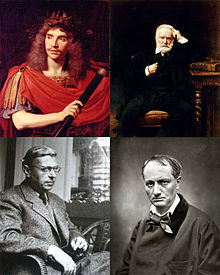
The earliest French literature dates from the Middle Ages, when what is now known as modern France did not have a single, uniform language. There were several languages and dialects and writers used their own spelling and grammar. Some authors of French mediaeval texts are unknown, such as Tristan and Iseult and Lancelot-Grail. Other authors are known, for example Chrétien de Troyes and Duke William IX of Aquitaine, who wrote in Occitan.
Much mediaeval French poetry and literature were inspired by the legends of the Matter of France, such as The Song of Roland and the various chansons de geste. The Roman de Renart, written in 1175 by Perrout de Saint Cloude, tells the story of the mediaeval character Reynard ('the Fox') and is another example of early French writing.
An important 16th century writer was François Rabelais, whose novel Gargantua and Pantagruel has remained famous and appreciated until now. Michel de Montaigne was the other major figure of the French literature during that century. His most famous work, Essais, created the literary genre of the essay. French poetry during that century was embodied by Pierre de Ronsard and Joachim du Bellay. Both writers founded the La Pléiade literary movement.
During the 17th century, Madame de La Fayette published anonymously La Princesse de Clèves, a novel that is considered to be one of the very first psychological novels of all times. Jean de La Fontaine is one of the most famous fabulist of that time, as he wrote hundreds of fables, some being far more famous than others, such as The Ant and the Grasshopper. Generations of French pupils had to learn his fables, that were seen as helping teaching wisdom and common sense to the young people. Some of his verses have entered the popular language to become proverbs.
Jean Racine, whose incredible mastery of the alexandrine and of the French language has been praised for centuries, created plays such as Phèdre or Britannicus. He is, along with Pierre Corneille ( Le Cid) and Molière, considered as one of the three great dramatists of the France's golden age. Molière, who is deemed to be one of the greatest masters of comedy of the Western literature, wrote dozens of plays, including Le Misanthrope, L'Avare, Le Malade imaginaire, and Le Bourgeois Gentilhomme. His plays have been so popular around the world that French language is sometimes dubbed as "the language of Molière" (la langue de Molière), just like English is considered as "the language of Shakespeare".
French literature and poetry flourished even more in the 18th and 19th centuries. Denis Diderot's best-known works are Jacques the Fatalist and Rameau's Nephew. He is however best known for being the main redactor of the Encyclopédie, whose aim was to sum up all the knowledge of his century (in fields such as arts, sciences, languages, philosophy) and to present them to the people, in order to fight ignorance and obscurantism. During that same century, Charles Perrault was a prolific writer of famous children's fairy tales including Puss in Boots, Cinderella, Sleeping Beauty and Bluebeard. At the start of the 19th century, symbolist poetry was an important movement in French literature, with poets such as Charles Baudelaire, Paul Verlaine and Stéphane Mallarmé.
The 19th century saw the writings of many renowned French authors. Victor Hugo is sometimes seen as "the greatest French writer of all times" for excelling in all literary genres. The preface of his play Cromwell is considered to be the manifesto of the Romantic movement. Les Contemplations and La Légende des siècles are considered as "poetic masterpieces", Hugo's verse having been compared to that of Shakespeare, Dante and Homer. His novel Les Misérables is widely seen as one of the greatest novel ever written and The Hunchback of Notre Dame has remained immensely popular.
Other major authors of that century include Alexandre Dumas ( The Three Musketeers and The Count of Monte-Cristo), Jules Verne ( Twenty Thousand Leagues Under the Sea), Émile Zola ( Les Rougon-Macquart), Honouré de Balzac ( La Comédie humaine), Guy de Maupassant, Théophile Gautier and Stendhal ( The Red and the Black, The Charterhouse of Parma), whose works are amongst the most well known in France and the world.
The Prix Goncourt is a French literary prize first awarded in 1903. Important writers of the 20th century include Marcel Proust, Louis-Ferdinand Céline, Albert Camus, and Jean-Paul Sartre. Antoine de Saint Exupéry wrote Little Prince which has remained popular for decades with children and adults around the world. As of 2010, French authors had more Literature Nobel Prizes than those of any other nation.
Philosophy
Medieval philosophy was dominated by Scholasticism until the emergence of Humanism in the Renaissance. Modern philosophy began in France in the 17th century with the philosophy of René Descartes, Blaise Pascal, and Nicolas Malebranche. Descartes revitalised Western philosophy that had been on the decline after the Greek and Roman eras. His Meditations on First Philosophy changed the primary object of philosophical thought and raised some of the most fundamental problems for foreigners such as Spinoza, Leibniz, Hume, Berkeley, and Kant.
During the 18th century, French philosophers produced one of the most important works of the Age of Enlightenment. In The Spirit of the Laws, Baron de Montesquieu theorized the principle of separation of powers, that has been implemented in all liberal democracies since it was first applied in the United States. In The Social Contract, Jean-Jacques Rousseau openly criticized the European divine right monarchies and strongly affirmed the principle of the sovereignty of the people. Voltaire came to embody the Enlightenment with his defence of civil liberties such as the right to a free trial and freedom of religion.
19th century French thought was targeted at responding to the social malaise following the French Revolution. Rationalist philosophers such as Victor Cousin and Auguste Comte, who called for a new social doctrine, were opposed by reactionnary thinkers such as Joseph de Maistre, Louis de Bonald and Lamennais, who blamed the rationalist rejection of traditional order. De Maistre is considered, together with the Englishman Edmund Burke, one of the founders of European conservatism, while Comte is regarded as the founder of positivism and sociology.
In the early 20th century, French spiritualist thinkers such as Maine de Biran, Henri Bergson and Louis Lavelle, influenced Anglo-Saxon thought, including the Americans Charles Sanders Peirce and William James, and the Englishman Alfred North Whitehead. In the late 20th century, partly influenced by German phenomenology and existentialism, postmodern philosophy began in France, with notable post-structuralist thinkers including Jean-François Lyotard, Jean Baudrillard, Jacques Derrida, Jacques Lacan, Michel Foucault and Gilles Deleuze.
Sciences

France has been since the Middle Ages a major focus of knowledge and discoveries. The University of Paris, founded in the mid-12th century, is still one of the most important universities of the Western world.
In the 17th century, René Descartes defined a method for the acquisition of scientific knowledge, while Blaise Pascal became famous for his work on probability and fluid mechanics. They were both key figures of the Scientific revolution which erupted in Europe during this period. The Academy of Sciences was founded by Louis XIV to encourage and protect the spirit of French scientific research. It was at the forefront of scientific developments in Europe in the 17th and 18th centuries. It is one of the earliest academies of sciences.
The Age of Enlightenment was marked by the work of biologist Buffon and chemist Lavoisier, who discovered the role of oxygen in combustion, while Diderot and D'Alembert published the Encyclopédie which aimed to give access to "useful knowledge" to the people, a knowledge that they can apply to their everyday life.
With the Industrial Revolution, the 19th century saw spectacular scientifical developments in France with scientists such as Augustin Fresnel, founder of modern optics, Sadi Carnot who laid the foundations of thermodynamics, or Louis Pasteur, a pioneer of microbiology. Other eminent French scientists of the 19th century have their names inscribed on the Eiffel Tower.
Famous French scientists of the 20th century include the mathematician and physicist Henri Poincaré, physicists Henri Becquerel, Pierre and Marie Curie, remained famous for their work on radioactivity, the physicist Paul Langevin or virologist Luc Montagnier, co-discoverer of HIV AIDS.
As of 2012, 65 French people have been awarded a Nobel Prize and 11 have received the Fields Medal.
Music
France has a long and varied musical history. It experienced a golden age in the 17th century thanks to Louis XIV, who employed several musicians and composers in the royal court. The most renowned composers of this period include Marc-Antoine Charpentier, François Couperin, Michel-Richard Delalande, Jean-Baptiste Lully and Marin Marais, all of them composers at the court. After the death of the "Roi Soleil", French musical creation lost dynamism, but in the next century the music of Jean-Philippe Rameau reached some prestige, and today he is still one of the most renowned French composers.
French classical music knew a revival in the 19th and 20th century, at the end of the romantic movement, at first with opera composers Hector Berlioz, Georges Bizet, Gabriel Fauré, Charles Gounod, Jacques Offenbach, Édouard Lalo, Jules Massenet and Camille Saint-Saëns. This period was a golden age for operas, being popular in the country the opéra bouffon, the opera-ballet and the opéra comique genres. Later came precursors of modern classical music Érik Satie, Francis Poulenc, and above all Maurice Ravel and Claude Debussy, who invented new musical forms. More recently, at the middle of the 20th century, Maurice Ohana, Pierre Schaeffer and Pierre Boulez contributed to the evolutions of contemporary classical music.
French music then followed the rapid emergence of pop and rock music at the middle of the 20th century. Although English-speaking creations achieved popularity in the country, French pop music, known as chanson française, has also remained very popular. Among the most important French artists of the century are Édith Piaf, Georges Brassens, Léo Ferré, Charles Aznavour and Serge Gainsbourg. Although there are very few rock bands in France compared to English-speaking countries, bands such as Noir Désir, Mano Negra, Niagara, Les Rita Mitsouko and more recently Superbus, Phoenix and Gojira have reached worldwide popularity.
Other French artists with international careers have been popular in several countries, for example female singers Dalida, Mireille Mathieu and Mylène Farmer, electronic music pioneers Jean-Michel Jarre, Laurent Garnier and Bob Sinclar, and later Martin Solveig and David Guetta. In the 1990s and 2000s (decade), electronic duos Daft Punk, Justice and Air also reached worldwide popularity and contributed to the reputation of modern electronic music in the world.
Among current musical events and institutions in France, many are dedicated to classical music and operas. The most prestigious institutions are the state-owned Paris National Opera (with its two sites Palais Garnier and Opéra Bastille), the Opéra National de Lyon, the Théâtre du Châtelet in Paris, the Théâtre du Capitole in Toulouse and the Grand Théâtre de Bordeaux. As for music festivals, there are several events organized, the most popular being the Eurockéennes and Rock en Seine. The Fête de la Musique, imitated by many foreign cities, was first launched by the French government in 1982. Major music halls and venues in France include Le Zénith sites present in many cities and other places in Paris ( Paris Olympia, Théâtre Mogador, Élysée Montmartre, etc.).
Cinema
France has historical and strong links with cinema. It is two Frenchmen, Auguste and Louis Lumière (known as the Lumière Brothers) who created the cinema in 1895. More recently, in 2006, France produced more films than any other European country. Cannes Festival is one of the most important and famous film festivals in the world.
Although the French film market is dominated by Hollywood, it is however the Western country (out of the United States) where the share of the American films in the total film revenues is the smallest, at 50.1%, to compare with 77.3% of Germany and 69.4% of Japan. Thus, French films account for 34.8% of the total film revenues of France, which is the highest percentage of national films revenues in developed countries (the U.S. not included), to compare with 13.7% in Spain and 8.3% in the UK.
France was for centuries, and not so long ago, the cultural centre of the world. But France's dominant position has been overthrown by American culture, and thus France tries to protect its culture. France has been a strong advocate of the cultural exception. France therefore succeeded in convincing all the EU members to refuse to include culture and audiovisuals in the list of liberalized sectors of the WTO in 1993.
Moreover, this decision was confirmed in a voting in the UNESCO in 2005, and the principle of "cultural exception" won an overwhelming victory: 198 countries voted for it, only 2 countries, the U.S and Israel, voted against it.
Fashion
Fashion has been an important industry and cultural export of France since the 17th century, and modern "haute couture" originated in Paris in the 1860s. Today, Paris, along with London, Milan, and New York City, is considered one of the world's fashion capitals, and the city is home or headquarters to many of the premier fashion houses. The expression Haute couture is, in France, a legally protected name, guaranteeing certain quality standards.
The association of France with fashion and style (French: la mode) dates largely to the reign of Louis XIV when the luxury goods industries in France came increasingly under royal control and the French royal court became, arguably, the arbiter of taste and style in Europe. But France renewed its dominance of the high fashion (French: couture or haute couture) industry in the years 1860–1960 through the establishing of the great couturier houses such as Chanel, Dior, and Givenchy.
In the 1960s, the elitist "Haute couture" came under criticism from France's youth culture. In 1966, the designer Yves Saint Laurent broke with established Haute Couture norms by launching a prêt-à-porter ("ready to wear") line and expanding French fashion into mass manufacturing. With a greater focus on marketing and manufacturing, new trends were established by Sonia Rykiel, Thierry Mugler, Claude Montana, Jean-Paul Gaultier and Christian Lacroix in the 1970s and 1980s. The 1990s saw a conglomeration of many French couture houses under luxury giants and multinationals such as LVMH.
Society
According to a 2010 BBC poll based on 29,977 responses in 28 countries, France is globally seen as a positive influence in the world's affairs: 49% have a positive view of the country's influence, whereas 19% have a negative view. The Nation Brand Index of 2008 suggested that France has the second best international reputation, only behind Germany.
According to two Pew Research Centre polls in 2006 and 2011 based on around 14 000 responses in 15 countries, French were found to have the highest level of religious tolerance (when asked about their opinion about Muslims, Christians and Jews) and to be the country where the highest proportion of the population defines its identity primarily in term of nationality and not of religion. 69% of French have a favorable view of the U.S., making France one of the most pro-American countries in the world.
In January 2010, the magazine International Living ranked France as "best country to live in", ahead of 193 other countries surveyed, for the fifth year running, according to a survey taking in account 9 criteria of quality of life: Cost of Living, Culture and Leisure, Economy, Environment, Freedom, Health, Infrastructure, Safety and Risk and Climate.
France has historical strong ties with Human Rights. Since the Declaration of the Rights of Man and of the Citizen of 1789, France is often nicknamed as "the country of Human Rights". Furthermore, in 1948, a Frenchman, René Cassin, was one of the main redactors of the Universal Declaration of Human Rights which was adopted by the UN members in Paris.
National symbols strongly reflect the heritage of the Revolution. The four official symbols of the Republic, as stated by the Constitution, all commemorate events from the period. Bastille Day, the national holiday, commemorate the Fête de la Fédération, held on 14 July 1790 to celebrate the storming of the Bastille. The origins of Tricolored flag also date back to the Revolution, as the cockade was the symbols adopted by the revolutionaries in 1789.
As for the national anthem La Marseillaise, it was written in 1792 as a war song for the French Army. The official motto of the French Republic, " Liberté, égalité, fraternité" (Liberty, equality, brotherhood) also appeared during the French Revolution. Marianne, unofficial symbol, is an allegorical figure of liberty and of the Republic and also appeared at the time of the Revolution.
A common and traditional symbol of the French people is the Gallic rooster. Its origins date back to Antiquity, since the Latin word Gallus meant both " rooster" and "inhabitant of Gaul". Then this figure gradually became the most widely shared representation of the French, used by French monarchs, then by the Revolution and under the successive republican regimes as representation of the national identity, used for some stamps and coins. Although it is not an official symbol of the Republic, it is the most common image to symbolize France in the collective imagination and abroad.
Gastronomy

French cuisine is renowned for being one of the finest in the world. French cuisine is extremely diverse and has exerted a major influence on other western cuisines. According to the regions, traditional recipes are different, the North of the country prefers to use butter as the preferred fat for cooking, whereas olive oil is more commonly used in the South.
Moreover, each region of France has iconic traditional specialities : Cassoulet in the Southwest, Choucroute in Alsace, Quiche in the Lorraine region, Beef bourguignon in the Bourgogne, provençal Tapenade, etc. France's most renowned products are wines, including Champagne, Bordeaux, Bourgogne, and Beaujolais as well as a large variety of different cheeses, such as Camembert, Roquefort and Brie. There are more than 400 different varieties.
French cuisine is also regarded as a key element of the quality of life and the attractiveness of France. A French publication, the Michelin guide, had by 2006 awarded 620 stars to French restaurants, at that time more than any other country, although the guide also inspects more restaurants in France than in any other country (by 2010, Japan was awarded as many Michelin stars as France, despite having half the number of Michelin inspectors working there).
Sports

Popular sports played in France include football, judo, tennis and basketball. France has hosted events such as the 1938 and 1998 FIFA World Cups, and hosted the 2007 Rugby Union World Cup. Stade de France in Saint-Denis is the largest stadium in France and was the venue for the 1998 FIFA World Cup final; it also hosted the 2007 Rugby World Cup final in October 2007. France also hosts the annual Tour de France, the most famous road bicycle race in the world. France is also famous for its 24 Hours of Le Mans sports car endurance race held in the Sarthe department. Several major tennis tournaments take place in France, including the Paris Masters and the French Open, one of the four Grand Slam tournaments. French martial arts include Savate and Fencing.
France has a close association with the Modern Olympic Games; it was a French aristocrat, Baron Pierre de Coubertin, who suggested the Games' revival, at the end of the 19th century. After Athens was awarded the first Games, in reference to the Greek origins of the ancient Olympics, Paris hosted the second Games in 1900. Paris was also the first home of the International Olympic Committee, before it moved to Lausanne. Since that 1900 Games, France has hosted the Olympics on four further occasions: the 1924 Summer Olympics, again in Paris and three Winter Games ( 1924 in Chamonix, 1968 in Grenoble and 1992 in Albertville).
Both the national football team and the national rugby union team are nicknamed “Les Bleus” in reference to the team’s shirt colour as well as the national French tricolor flag. The football team is among the most successful in the world, particularly at the start of the 21st century, with one FIFA World Cup victory in 1998, one FIFA World Cup second place in 2006, and two European Championships in 1984 and 2000. The top national football club competition is the Ligue 1. Rugby union is also very popular, particularly in Paris and the southwest of France. The national rugby union team has competed at every Rugby World Cup, and takes part in the annual Six Nations Championship. Following on from a strong domestic tournament, the French rugby team has won sixteen Six Nations Championships, including eight grand slams; and has reached the semi-finals (6 times) and the final (3 times) of the Rugby World Cup.
Rugby league in France is a sport that is most popular in the south, with cities such as Perpignan and Toulouse having a strong presence in the game. The Catalans Dragons currently play in Super League, which is the top tier rugby league competition in Europe. The Elite One Championship is the professional competition for rugby league clubs in France.
In the last decades, France has produced a high number of world-elite basketball players, most notably Tony Parker. The French National Basketball Team has won silver at the FIBA EuroBasket 2011, its best performance in over 60 years. In addition, the national team won two Olympic Silver Medals, one in 2000 and one in 1948.



![Location of Metropolitan France (dark green)– in Europe (green & dark grey)– in the European Union (green) — [Legend]](../../images/944/94461.png)
